headlights TOYOTA GT86 2017 1.G Owners Manual
[x] Cancel search | Manufacturer: TOYOTA, Model Year: 2017, Model line: GT86, Model: TOYOTA GT86 2017 1.GPages: 428, PDF Size: 7.83 MB
Page 6 of 428
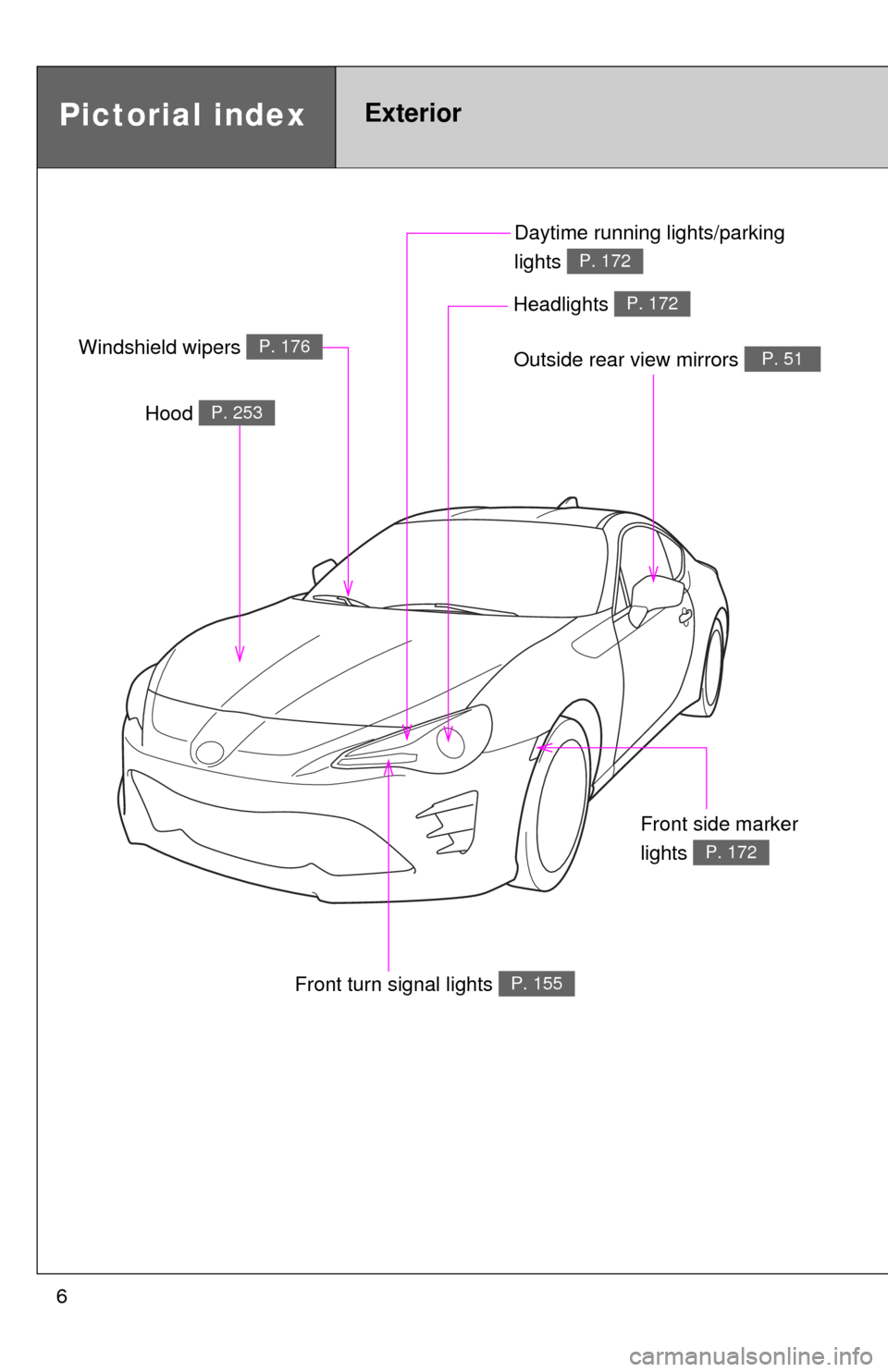
6Daytime running lights/parking
lights
P. 172
Pictorial indexExterior
Outside rear view mirrors P. 51
Front turn signal lights P. 155
Hood P. 253
Windshield wipers P. 176
Headlights P. 172
Front side marker
lights
P. 172
Page 50 of 428
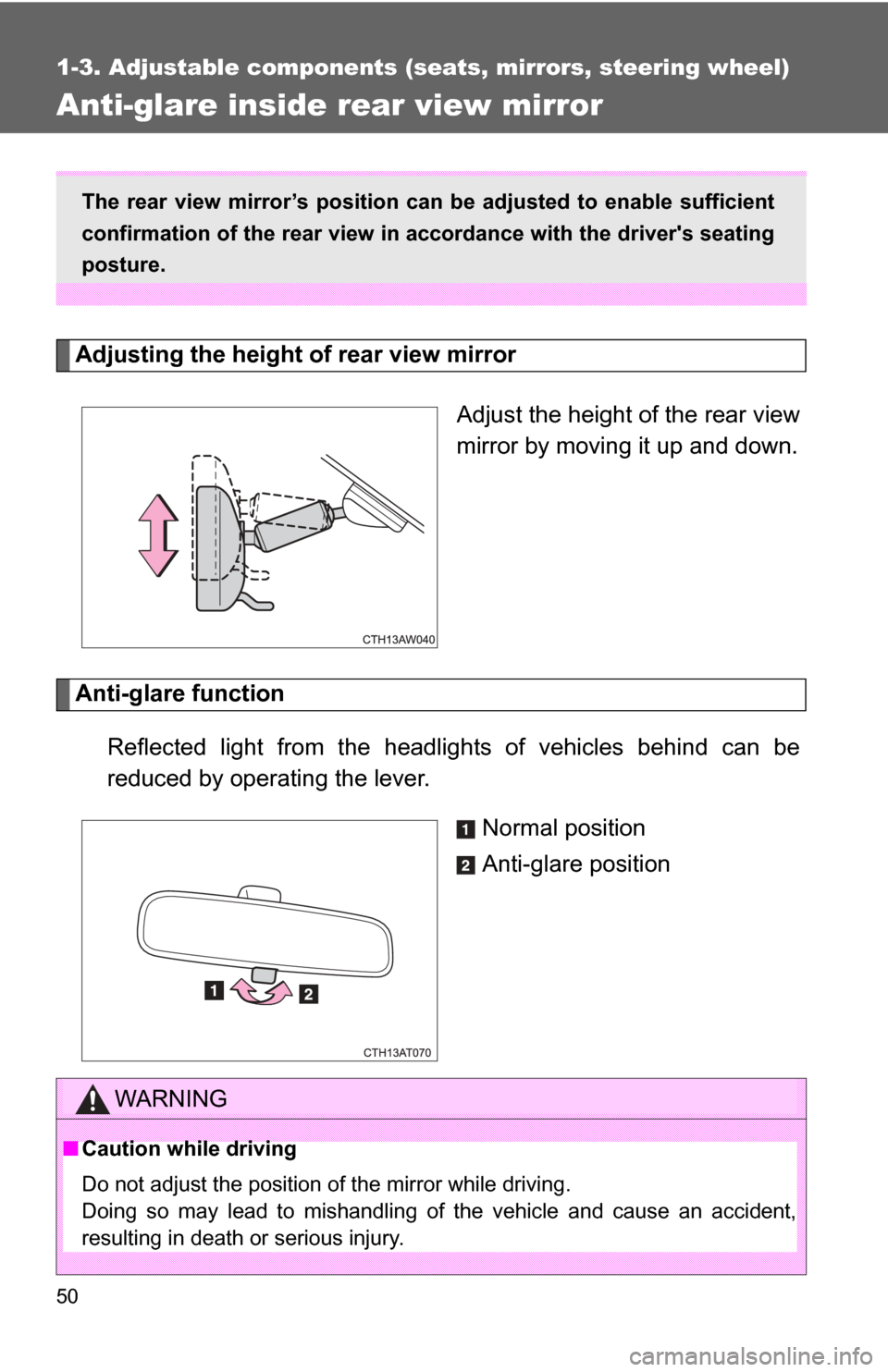
50
1-3. Adjustable components (seats, mirrors, steering wheel)
Anti-glare inside rear view mirror
Adjusting the height of rear view mirror Adjust the height of the rear view
mirror by moving it up and down.
Anti-glare functionReflected light from the headlights of vehicles behind can be
reduced by operating the lever. Normal position
Anti-glare position
The rear view mirror’s position can be adjusted to enable sufficient
confirmation of the rear view in accordance with the driver's seating
posture.
WARNING
■ Caution while driving
Do not adjust the position of the mirror while driving.
Doing so may lead to mishandling of the vehicle and cause an accident,
resulting in death or serious injury.
Page 159 of 428
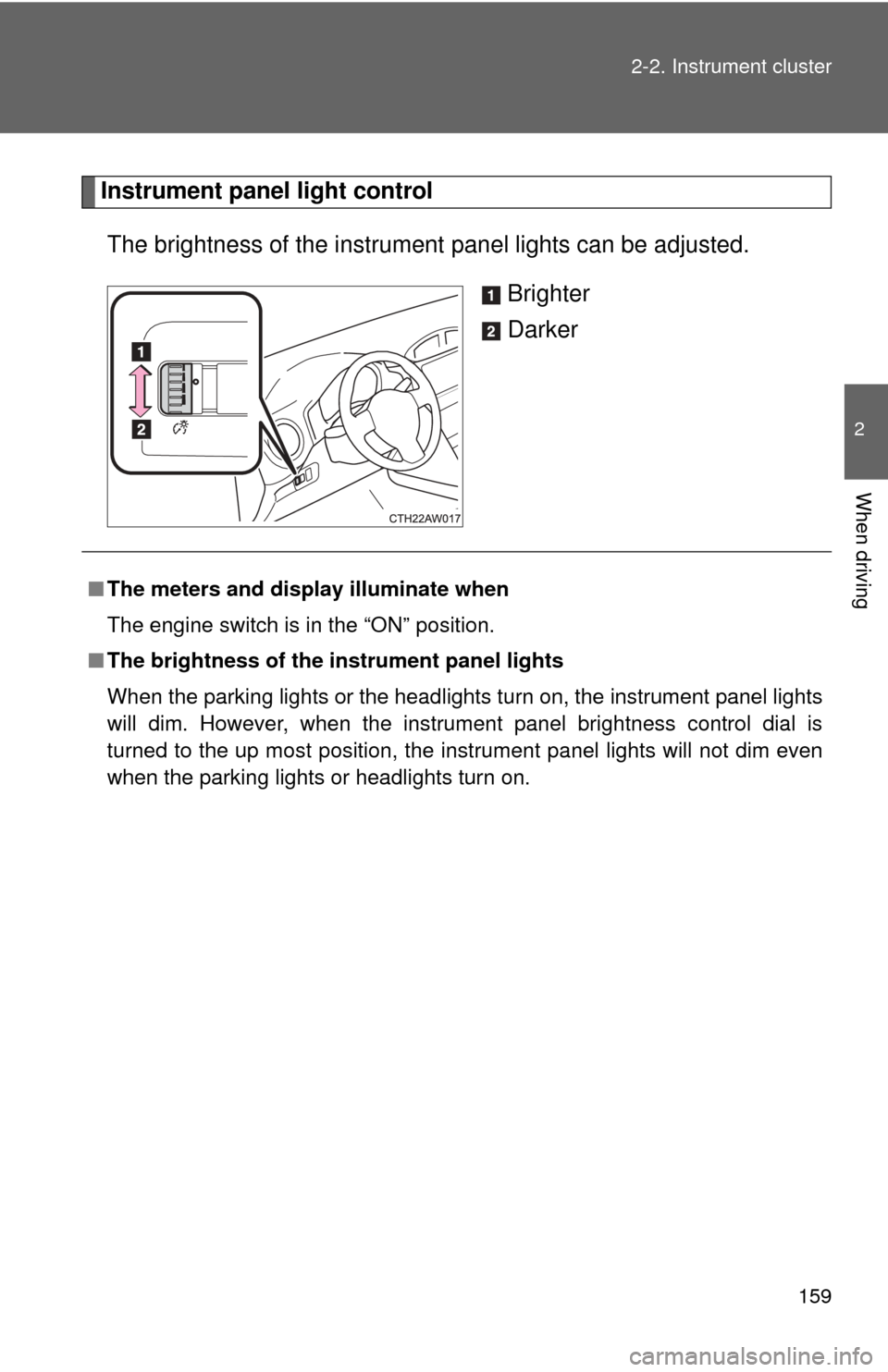
159
2-2. Instrument cluster
2
When driving
Instrument panel light control
The brightness of the instrument panel lights can be adjusted.
Brighter
Darker
■The meters and display illuminate when
The engine switch is in the “ON” position.
■ The brightness of the instrument panel lights
When the parking lights or the headlights turn on, the instrument panel lights
will dim. However, when the instrument panel brightness control dial is
turned to the up most position, the instrument panel lights will not dim even
when the parking lights or headlights turn on.
Page 172 of 428
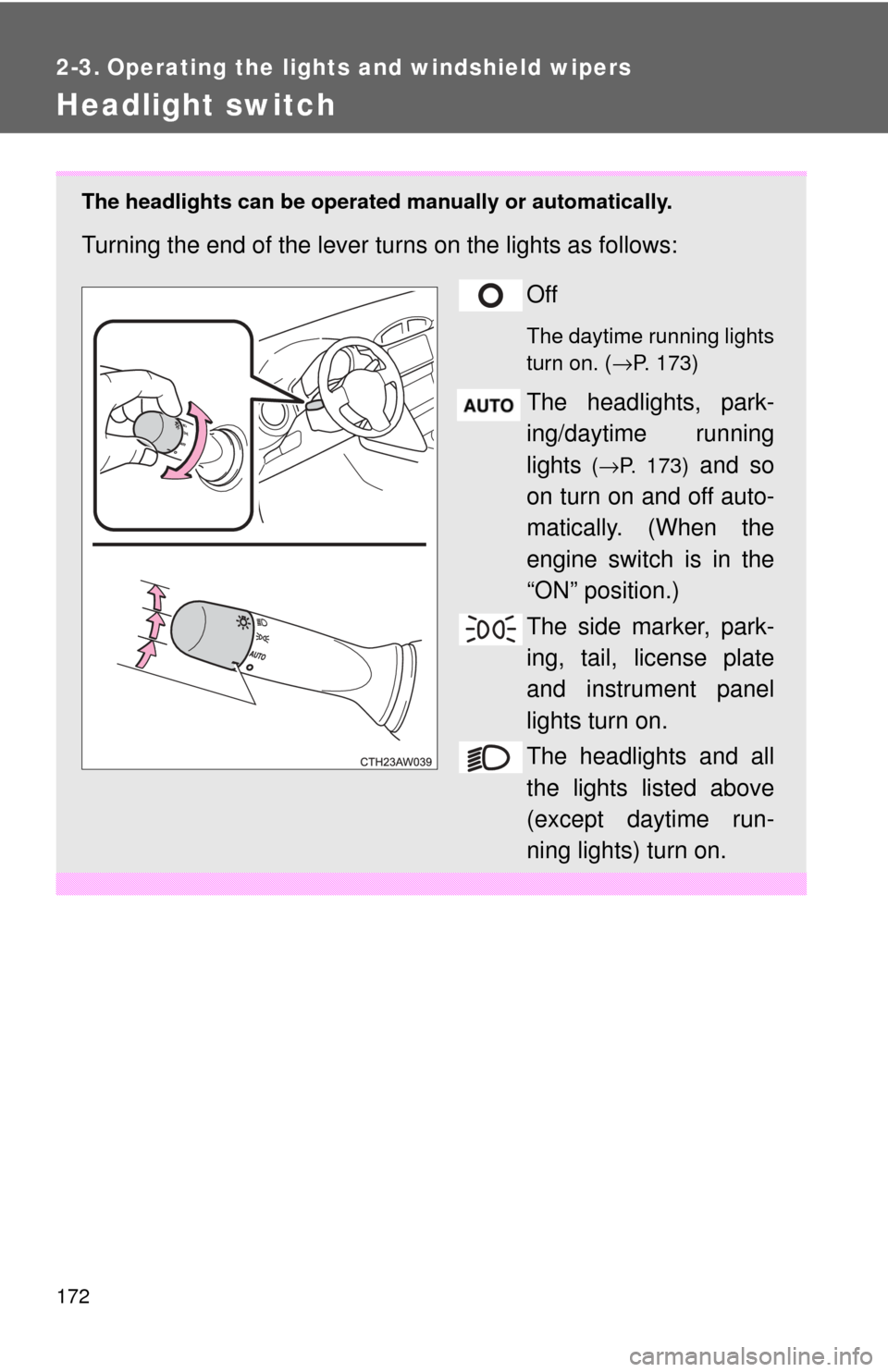
172
2-3. Operating the lights and windshield wipers
Headlight switch
The headlights can be operated manually or automatically.
Turning the end of the lever turns on the lights as follows:
Off
The daytime running lights
turn on. (→P. 173)
The headlights, park-
ing/daytime running
lights
(→P. 173) and so
on turn on and off auto-
matically. (When the
engine switch is in the
“ON” position.)
The side marker, park-
ing, tail, license plate
and instrument panel
lights turn on.
The headlights and all
the lights listed above
(except daytime run-
ning lights) turn on.
Page 173 of 428
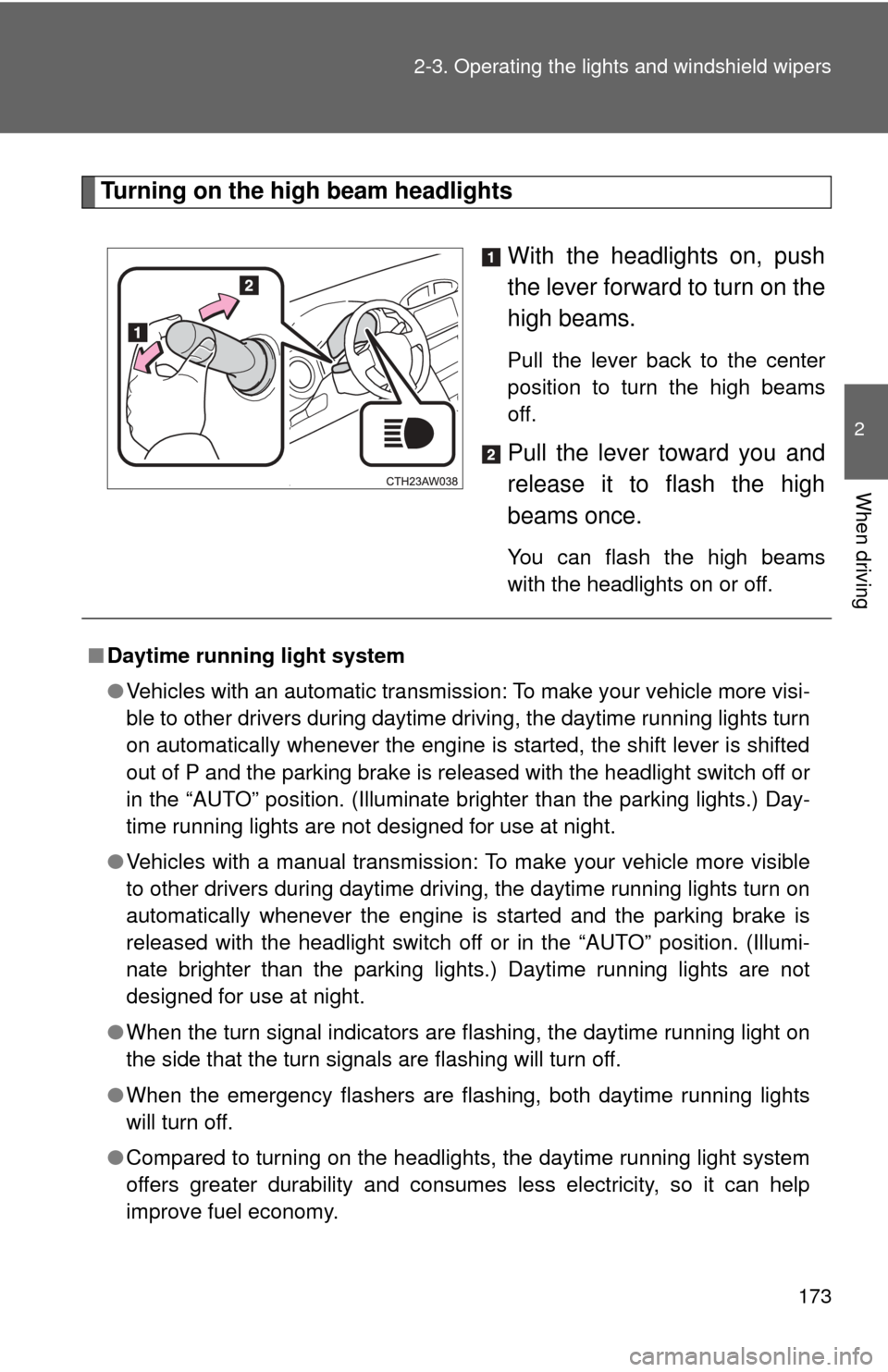
173
2-3. Operating the lights and windshield wipers
2
When driving
Turning on the high beam headlights
With the headlights on, push
the lever forward to turn on the
high beams.
Pull the lever back to the center
position to turn the high beams
off.
Pull the lever toward you and
release it to flash the high
beams once.
You can flash the high beams
with the headlights on or off.
■Daytime running light system
●Vehicles with an automatic transmission: To make your vehicle more visi-
ble to other drivers during daytime driving, the daytime running lights turn
on automatically whenever the engine is started, the shift lever is shifted
out of P and the parking brake is released with the headlight switch off or
in the “AUTO” position. (Illuminate brighter than the parking lights.) Day-
time running lights are not designed for use at night.
● Vehicles with a manual transmission: To make your vehicle more visible
to other drivers during daytime driving, the daytime running lights turn on
automatically whenever the engine is started and the parking brake is
released with the headlight switch off or in the “AUTO” position. (Illumi-
nate brighter than the parking lights.) Daytime running lights are not
designed for use at night.
● When the turn signal indicators are flashing, the daytime running light on
the side that the turn signals are flashing will turn off.
● When the emergency flashers are flashing, both daytime running lights
will turn off.
● Compared to turning on the headlights, the daytime running light system
offers greater durability and consumes less electricity, so it can help
improve fuel economy.
Page 174 of 428
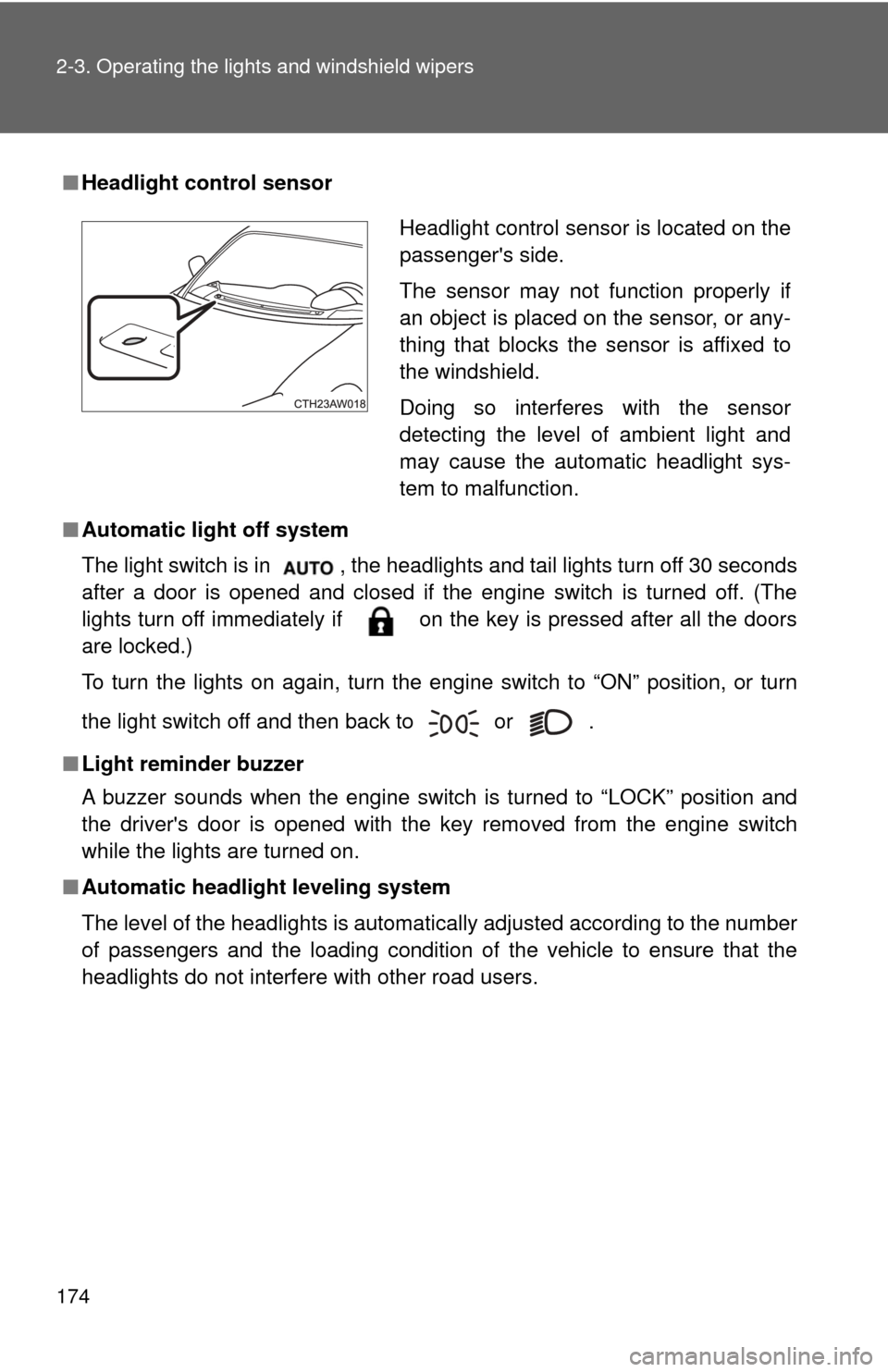
174 2-3. Operating the lights and windshield wipers
■Headlight control sensor
■ Automatic light off system
The light switch is in , the headlights and tail lights turn off 30 seconds
after a door is opened and closed if the engine switch is turned off. (The
lights turn off immediately if on the key is pressed after all the doors
are locked.)
To turn the lights on again, turn the engine switch to “ON” positio\
n, or turn
the light switch off and then back to
or .
■ Light reminder buzzer
A buzzer sounds when the engine switch is turned to “LOCK” position\
and
the driver's door is opened with the key removed from the engine switch
while the lights are turned on.
■ Automatic headlight leveling system
The level of the headlights is automatically adjusted according to the number
of passengers and the loading condition of the vehicle to ensure that the
headlights do not interfere with other road users.
Headlight control sensor is located on the
passenger's side.
The sensor may not function properly if
an object is placed on the sensor, or any-
thing that blocks the sensor is affixed to
the windshield.
Doing so interferes with the sensor
detecting the level of ambient light and
may cause the automatic headlight sys-
tem to malfunction.
Page 175 of 428
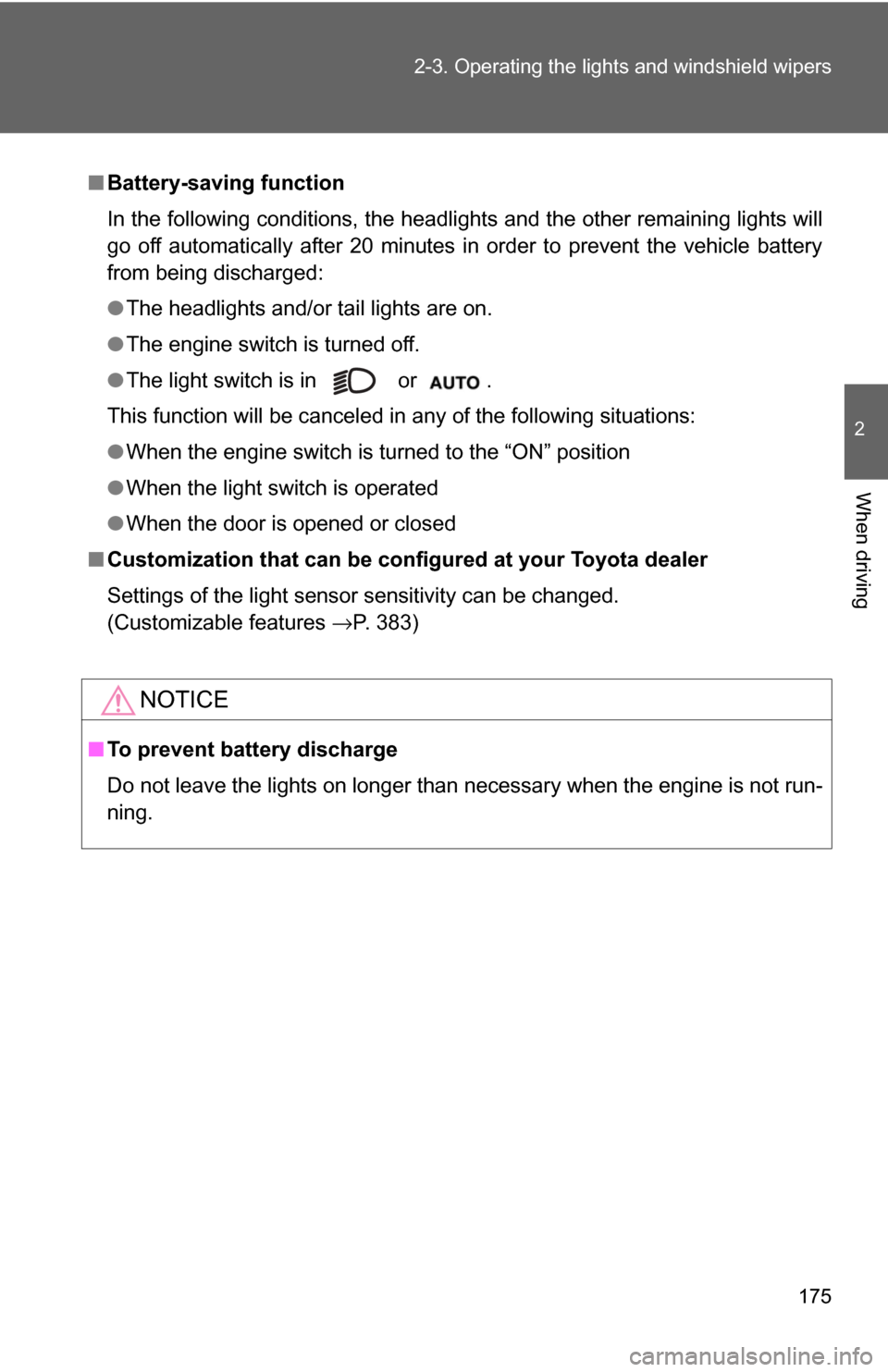
175
2-3. Operating the lights and windshield wipers
2
When driving
■
Battery-saving function
In the following conditions, the headlights and the other remaining lights will
go off automatically after 20 minutes in order to prevent the vehicle battery
from being discharged:
●The headlights and/or tail lights are on.
● The engine switch is turned off.
● The light switch is in or .
This function will be canceled in any of the following situations:
● When the engine switch is turned to the “ON” position
● When the light switch is operated
● When the door is opened or closed
■ Customization that can be configured at your Toyota dealer
Settings of the light sensor sensitivity can be changed.
(Customizable features →P. 383)
NOTICE
■To prevent battery discharge
Do not leave the lights on longer than necessary when the engine is not run-
ning.
Page 302 of 428
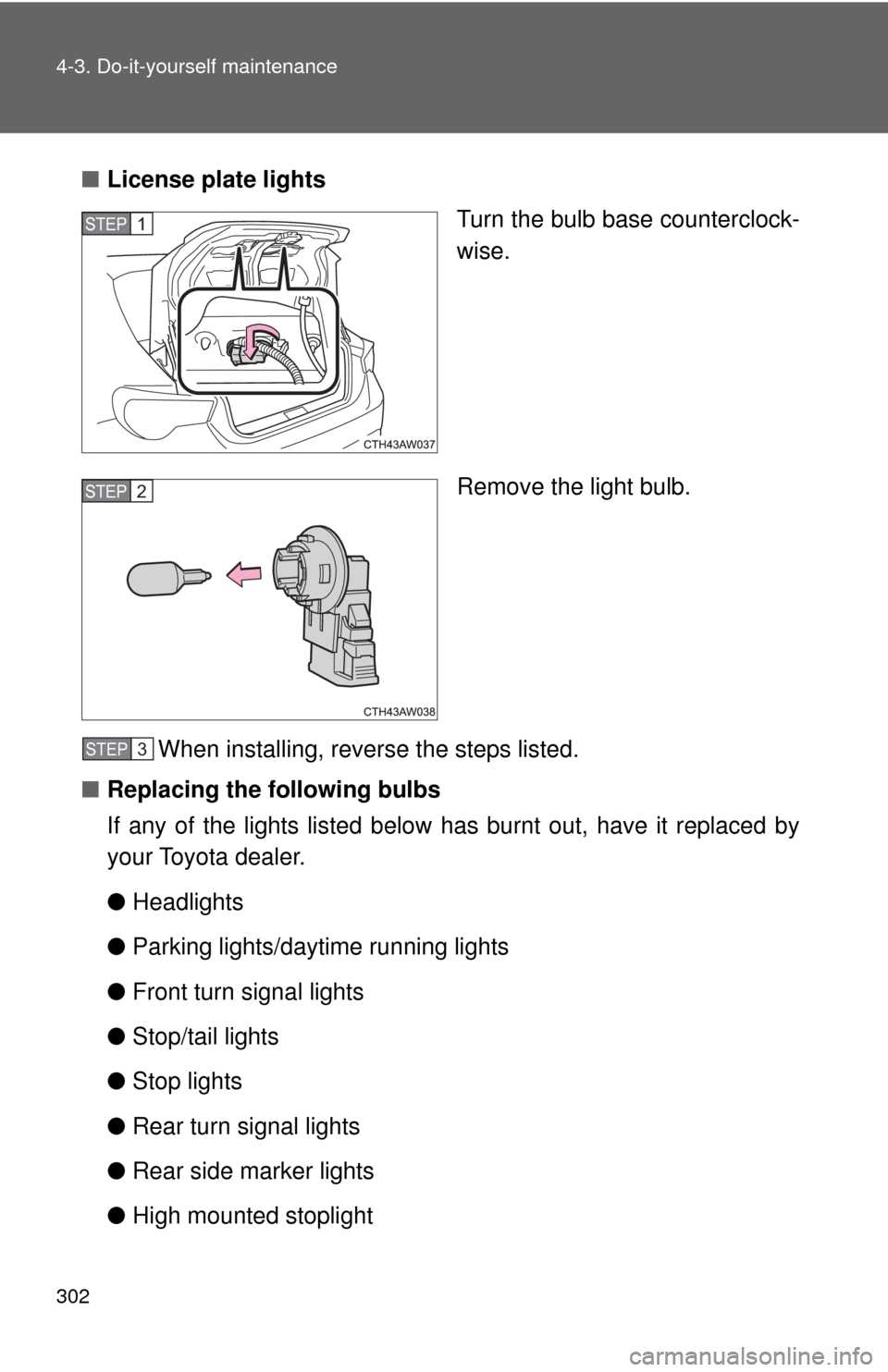
302 4-3. Do-it-yourself maintenance
■License plate lights
Turn the bulb base counterclock-
wise.
Remove the light bulb.
When installing, reverse the steps listed.
■ Replacing the following bulbs
If any of the lights listed below has burnt out, have it replaced by
your Toyota dealer.
●Headlights
● Parking lights/daytime running lights
● Front turn signal lights
● Stop/tail lights
● Stop lights
● Rear turn signal lights
● Rear side marker lights
● High mounted stoplight
STEP 1
STEP 2
STEP 3
Page 303 of 428
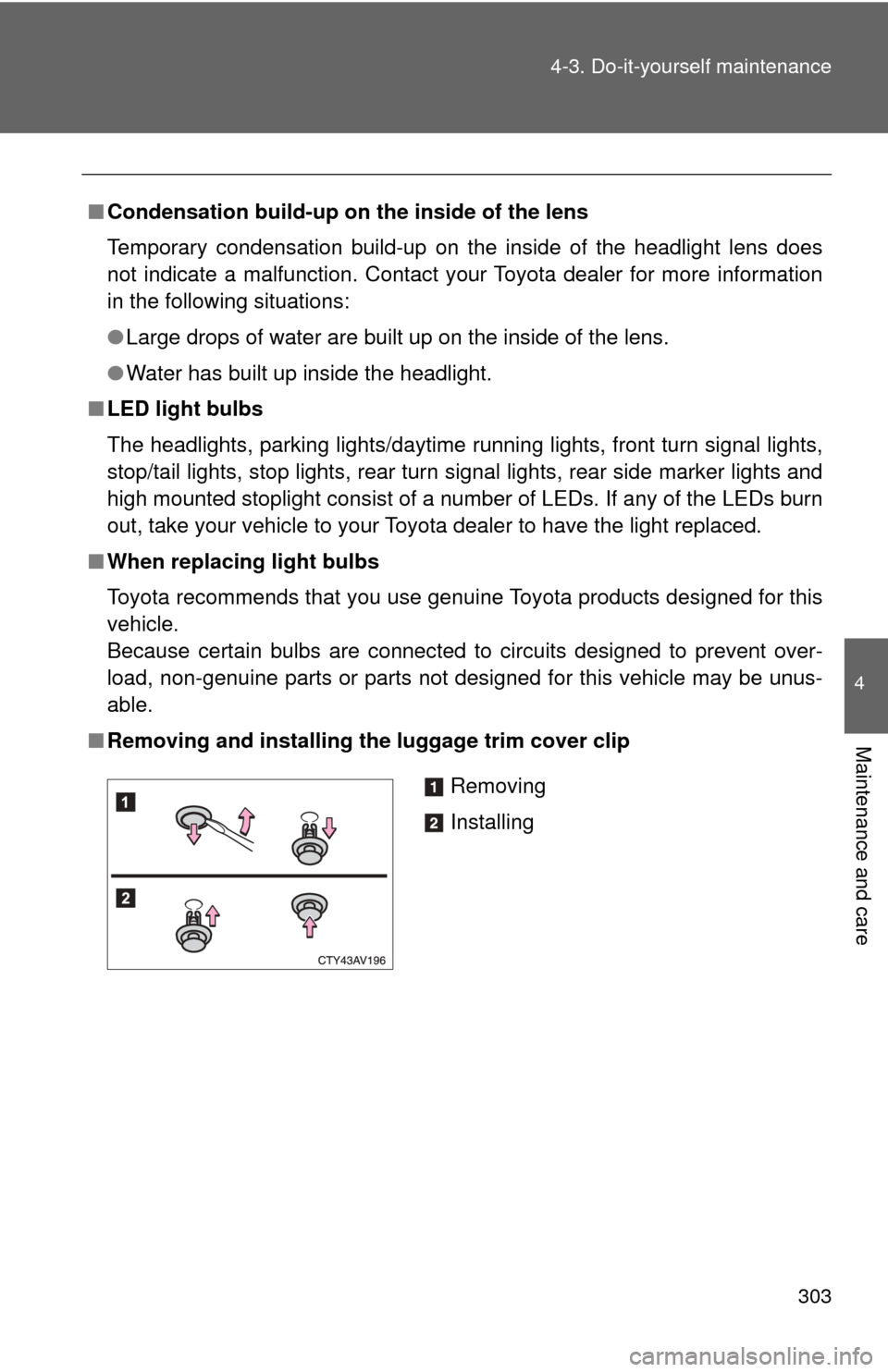
303
4-3. Do-it-yourself maintenance
4
Maintenance and care
■
Condensation build-up on th e inside of the lens
Temporary condensation build-up on the inside of the headlight lens does
not indicate a malfunction. Contact your Toyota dealer for more information
in the following situations:
● Large drops of water are built up on the inside of the lens.
● Water has built up inside the headlight.
■ LED light bulbs
The headlights, parking lights/daytime running lights, front turn signal li\
ghts,
stop/tail lights, stop lights, rear turn signal lights, rear side marker lights and
high mounted stoplight consist of a number of LEDs. If any of the LEDs burn
out, take your vehicle to your Toyota dealer to have the light replaced.
■ When replacing light bulbs
Toyota recommends that you use genuine Toyota products designed for this
vehicle.
Because certain bulbs are connected to circuits designed to prevent over-
load, non-genuine parts or parts not designed for this vehicle may be unus-
able.
■ Removing and installing the luggage trim cover clip
Removing
Installing
Page 338 of 428
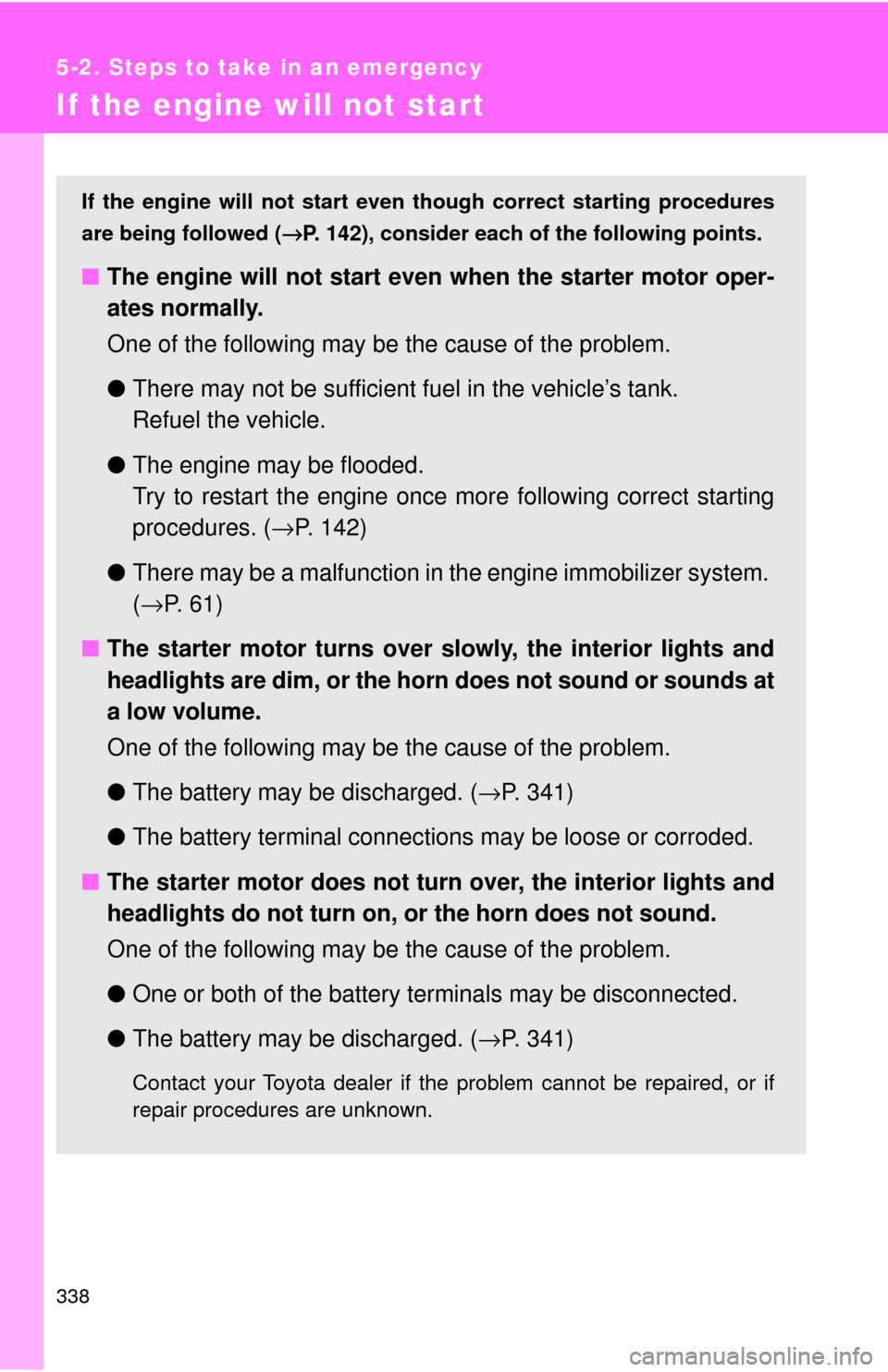
338
5-2. Steps to take in an emergency
If the engine will not start
If the engine will not start even though correct starting procedures
are being followed ( →P. 142), consider each of the following points.
■The engine will not start even when the starter motor oper-
ates normally.
One of the following may be the cause of the problem.
● There may not be sufficient fuel in the vehicle’s tank.
Refuel the vehicle.
● The engine may be flooded.
Try to restart the engine once more following correct starting
procedures. ( →P. 142)
● There may be a malfunction in the engine immobilizer system.
(→ P. 6 1 )
■ The starter motor turns over slowly, the interior lights and
headlights are dim, or the hor n does not sound or sounds at
a low volume.
One of the following may be the cause of the problem.
● The battery may be discharged. ( →P. 341)
● The battery terminal connec tions may be loose or corroded.
■ The starter motor does not turn over, the interior lights and
headlights do not turn on, or the horn does not sound.
One of the following may be the cause of the problem.
● One or both of the battery terminals may be disconnected.
● The battery may be discharged. ( →P. 341)
Contact your Toyota dealer if the problem cannot be repaired, or if
repair procedures are unknown.